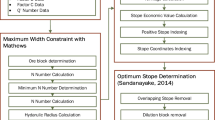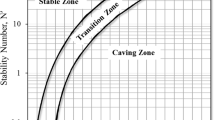Abstract
The stability graph method for open stope design is one of the most widely used approaches for predicting the stability of stopes in underground metalliferous mines. The primary purpose of this work is to propose a new stability chart, which includes all relevant case histories, and to exclude parameters with uncertainties for determining stability number. The modified stability number was used to achieve this goal, and the Extended Mathews database was recalculated and compared with the new stability graph. In this study, a new refined Consolidated stability graph was developed by excluding the entry mining methods data from the Extended graph data, and only the non-entry methods data was used. The applicability of the proposed Consolidated stability chart was demonstrated by an open stope example. The probabilities of stability for each stope surface were determined using the logistic regression model and the developed Consolidated stability chart. Comparing the stability analysis results with that of other published works of the same example shows that the determined Consolidated chart, in which the entry-method data is excluded, produces a more conservative and safer design. In conclusion, the size and quality of the dataset dictate the reliability of this approach.













Similar content being viewed by others
Abbreviations
- A:
-
Rock stress factor
- B:
-
Joint orientation adjustment factor
- C:
-
Gravity adjustment factor
- CDF:
-
Cumulative distribution function
- ELOS:
-
Equivalent linear overbreak/slough
- F:
-
Fault factor
- HR:
-
Hydraulic radius (in meters)
- Ja :
-
Joint alteration number
- Jn :
-
Joint set number
- Jr :
-
Joint roughness number
- Jw :
-
Joint water reduction factor
- JKMRC:
-
Julius Kruttschnitt Mineral Research Centre
- K:
-
Stress ratio (σH:σV)
- N:
-
Mathews stability number
- N′:
-
Modified stability number
- NGI:
-
Norwegian Geotechnical Institute
- P:
-
Predicted logit value
- Q:
-
Tunnelling Quality Index, referred to as the Q value
- Q′:
-
Modified Q value
- RF:
-
Radius factor
- RMR:
-
Rock mass rating (Bieniawski)
- S:
-
Shape factor
- SRF:
-
Stress reduction factor
- X1 … Xk :
-
Dependent X variables in the logit model
- Z:
-
Predicted log odds value
- a:
-
Regression parameter without dependent X variable. A constant in the logit regression equation
- f(z):
-
Predicted logit probability value
References
Barton NR, Lien R, Lunde J (1974) Engineering classification of rock masses for the design of tunnel support. Rock Mech 6(4):189–239
Bieniawski ZT (1973) Engineering classification of jointed rock masses. Civil Eng S Afr 15(12):335–343
Clark L, Pakalnis R (1997) An empirical design approach for estimating unplanned dilution from open stope hanging walls and footwalls. In: Proceedings of the 99th annual general meeting. Canadian Institute of Mining, Metallurgy and Petroleum, Vancouver
Hoek E, Kaiser PK, Bawden WF (1995) Support of underground excavations in Hard Rock. Balkema, Rotterdam, p 215
Laubscher DH, Taylor HW (1976) The importance of geomechanics classification of jointed rock masses in mining operations. In: Proceedings of the symposium on exploration for rock engineering, Johannesburg, South Africa
Liao TF (1994) Interpreting Probability models: logit, probit, and other generalized linear models. Sage University Paper series on quantitative applications in the social sciences. Sage, CA, p 88
Mathews KE, Hoek E, Wyllie DC, Stewart SBV (1981) Prediction of stable excavation spans at depths below 1000m in hard rock mines. CANMET Report, DSS Serial No. OSQ80-00081
Mawdesley C (2002) Predicting rock mass cavability in block caving mines. Dissertation, The University of Queensland
Mawdesley C, Trueman R, Whiten WJ (2001) Extending the Mathews stability graph for open–stope design. Min Technol 110(1):27–39
Milne DM, Pakalnis RC, Lunder PJ (1996) Approach to the quantification of hanging-wall behaviour. Trans Inst Min Metall Sect A Min Ind 105:A64-69
Nickson SD (1992) Cable support guidelines for underground hard rock mine operations. Ph.D. Dissertation, University of British Columbia
Potvin Y (1988) Empirical open stope design in Canada. Ph.D. Dissertation, University of British Columbia
Potvin Y, Hadjigeorgiou J (2001) The stability graph method. Undergr Min Methods 66:513–520
Stewart PC (2005) Minimizing dilution in narrow vein mines. PhD Dissertation, Julius Kruttschnitt Mineral Research Centre, The University of Queensland
Stewart SBV, Forsyth WW (1995) The Mathew’s method for open stope design. CIM Bull 88(992):45–53
Stewart PC, Trueman R (2001) The Extended Mathews stability graph: quantifying case history requirements and site-specific effects. In: International symposium on mining techniques, pp 84–92
Suorineni FT (1998) Effects of faults and stress on open stope design. Ph.D. Dissertation, University of Waterloo
Suorineni FT, Henning JG, Kaiser PK (2001) Narrow-vein mining experiences at Ashanti: case study. International National Symposium, Mining techniques of Narrow-vein Deposits. Canadian Institute of Mining, Metallurgy and Petroleum, Val’Dor
Trueman R, Mawdesley C (2003) Predicting cave initiation and propagation. CIM Bull 96(1071):54–59
Trueman R, Mikula P, Mawdesley CA, Harries N (2000) Experience in Australia with the application of the Mathew’s method for open stope design. CIM Bull 93(1036):162–167
Vallejos JA, Delonca A, Perez E (2018) Three-dimensional effect of stresses in open stope mine design. Int J Min Reclam Environ 32(5):355–374
Author information
Authors and Affiliations
Corresponding author
Ethics declarations
Conflict of interest
The authors declare that they have no conflict of interest, and this study was not funded by any organization.
Additional information
Publisher's Note
Springer Nature remains neutral with regard to jurisdictional claims in published maps and institutional affiliations.
Rights and permissions
About this article
Cite this article
Mortazavi, A., Osserbay, B. The Consolidated Mathews Stability Graph for Open Stope Design. Geotech Geol Eng 40, 2409–2424 (2022). https://doi.org/10.1007/s10706-021-02034-0
Received:
Accepted:
Published:
Issue Date:
DOI: https://doi.org/10.1007/s10706-021-02034-0




